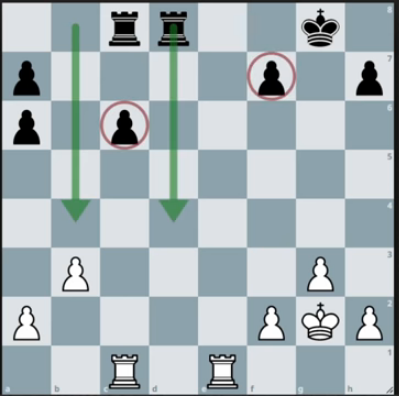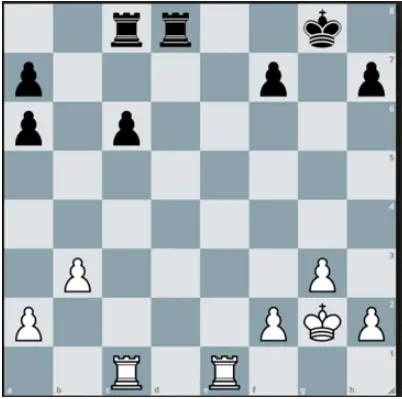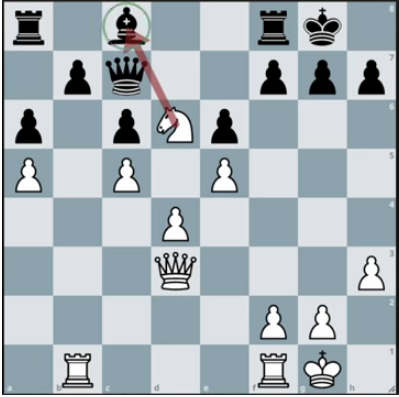Positional chess is simply any strategy or move that improves upon your position. This could include gaining space, finding more active squares for your pieces, or putting pressure on your opponent’s position.
There are many different positional concepts in chess. However, not all of them you will use, as the choice of strategy will depend on the nature and characteristics of the position.
All of these strategies should aim to achieve one common goal, and that is to improve your position for the better. If a move doesn’t improve your position, then it’s not considered a positional move.
In this article, we will discuss 10 of the best positional chess concepts that you can implement in your games. With that said, let’s jump right in.
Here are the top 10 positional chess concepts you need to know:
Top 10 Positional Chess Concepts
1. Avoid Bad Bishops
A bad bishop in chess is a bishop that is stuck behind its own pawns. Bishops perform well on long open diagonals, so you should avoid blocking them with your pawns as this restricts their mobility.
White created a bad bishop for himself by playing pawn to d3. Now the bishop is stuck behind the pawn chain.

Better move for white was to play Bishop to c4 which gets it along the open diagonal
If you ever end up with a bad bishop in your game, you should remove it from behind the pawn chain, or try to trade it off with one of your opponent’s active pieces.
A bishop that is completely locked behind it’s own pawns with no squares to go is considered a “tall pawn” which is even worse than a bad bishop. As the name suggest, the bishop’s worth is significantly reduced to a single point, equivalent to that of a pawn. In some positions, it is next to impossible to get rid of this “tall pawn”. Therefore, you should always be mindful when closing up the position as you could completely lock out your bishop for good, never being able to escape free.
White allowed black to close down the queenside, thereby permenently caging in white’s bishop

2. Target Isolated Pawns
An isolated pawn is considered a static weakness as it can last all the way into the endgame. This type of pawn cannot be protected by another pawn as there are no pawns along the adjacent files to support it.
Diagram showing isolated pawns on c6, f7, h7, a7, a6

Isolated pawns are good targets of attack as they cannot be protected by another pawn. You should look for isolated pawns in your position and find ways to use your minor and major pieces to attack them.
In the position above, black not only has isolated pawns, but he has double isolated pawns on the a-file. This is even worse because black cannot advance his a7 pawn forward as it’s being blocked by the a6 pawn. Creating doubled pawns and targeting them is often a very good positional strategy, not only in the endgame but also in the middlegame.
3. Rooks Belong On Open Files
Another positional concept you should know is that rooks should take control of open files in order for them to perform at their maximum ability. Placing your rook on open files also gives you a lot of options as the rook can invade on the 7th rank.
White controls the e-file, whereas black controls the d-file.

Rooks on the 7th rank are more powerful, as they can gobble up the opponent’s pawns. Whichever player controls the open file usually has the advantage. This is especially true in endgames. Therefore, you should always strive to get your rooks on the open file before your opponent gets to it first.
4. Never Trade A Good Bishop For Your Opponent’s Bad Knight
Theoretically and practically, bishops are stronger than knights as they can move across the board more quickly due to their long ranged scope. Knights on the other hand take several moves to go from one end of the board to the other.
If you have an active bishop, then you should avoid exchanging it off for your opponent’s bad knight. Many beginner and intermdiate players make the mistake of exchanging off their bishop for a knight.
A grandmaster will not do this unless it results in a positional advantage. For example, if the position is closed, then exchanging your bishop for a knight is sensible as bishops don’t do well behind pawns. However, in open positions, it’s best to retain your bishop pair.
White has an active bishop on g2

In the position above, white has an active fianchettoed bishop on g2 as it controls the central squares. It is also nicely hidden behind the pawns and cannot be easily harassed.
If white was to trade this bishop for the knight on c6, that would be a crucial mistake. Not only are you losing a very powerful bishop, but your weakening the light squares around your king.
5. Never Trade A Good Knight For A Bad Bishop
Though theoretically a bishop is slightly stronger than a knight, there are some positions where you should abstain from trading your good knight for your opponent’s bad bishop.
In the position below, it would be favorable for black if white was to go ahead and trade his strong knight on d6 for black’s passive bishop on c8.

The knight on d6 is extremely strong as it cannot be chased away from its outpost since there are no pieces on the dark squares to attack it. Black’s bishop is locked behind it’s own pawns making it a worthless piece. Therefore, it would be foolish of white to trade his knight for the bishop as white would lose the advantage.
6. Trade Your Bad Pieces For Your Opponent’s Good Pieces
While we are talking about trading, the next positional chess principle is to always look to trade your bad pieces for your opponent’s good pieces. This will help you to neutralize the position and eliminate any imbalances.
In the position below, black’s knight on d4 is very strong and well defended.

White cannot harass it with his pawns as they’ve already moved forward. White needs to find away to eliminate this active piece from off his territory as the knight is controlling a lot of squares in white’s half of the board.
If you ask youself this question, you will notice that there is a knight on e1 that is not doing anything. White could use this knight to remove black’s strong knight on d4. This trade will favor white as black would have lost his ‘strong’ knight on d4. White can achieve this by moving his knight to c2, in an attempt to capture the black knight.
7. Be Careful When Pushing Your Pawns Forward
The next principle is to be careful when moving your pawns forward. While there are some advantages in advancing your pawns forward (for example to create space), you also have to be careful not to overextend them.
Pawns that are overextended are easy targets of attack as they are less likely to be defended by other pawns. These pawns have advanced themselves way into the enemy’s half of the board, thereby making them easier targets of attack as opposed to if they were still in their intial position. This weakness is usually created when one side tries to attack their opponent early, but then the attack fizzles out. When the dust is cleared, you’ve left a whole lot of weakness in your position.
This is also true in the endgame. If you don’t have a pawn majority on the flank, then you should be mindful when pushing your pawns forward as they can become weaknesses.
So often I see players make the mistake of advancing their pawns forward in the endgame for no reason at all. You should not do this, unless you have a clear strategy.
8. Rooks Are Powerful On The 2nd Or 7th Rank
A rook on the 7th rank for white (or 2nd rank for black) is very powerful as it has the ability to gobble up all the opponent’s pawns on that rank.
To place 2 rooks on the 7th rank is even more powerful as this can lead to an attack against the king. Rooks on the 7th rank can also be a life savior if you find yourself in a losing position. You can sometimes get away with a draw by using your two rooks to check the king along the 7th rank. Therefore, if you ever find youself on the losing end, try to get your 2 rooks on the 7th rank.
Two rooks on the 7th rank is unstoppable in most positions

9. Freeze Your Opponent’s Pawn Majority
In some endgame positions, it’s a good idea to stop or freeze your opponent’s pawns from advancing. This is a strategy you need to know if you want to master the endgame.
In the position below, black has a pawn majority on the queenside.

Usually in such positions, black would be winning here, as his strategy will simply be to push his pawn majority, create the passed pawn, and promote it into a queen.
And, if the white king moves to the queenside of the board to try and stop the pawn from promoting, Black can use this distraction to gobble up the kingside pawns. The white king will not be able to attend to both sides of the board at the same time.
However, white can put a stop to all this shenanigan by playing the move to a5. This fixes black’s pawns on the queenside, thereby preventing them from advancing. If black tries to advance his b7 pawn to b5, white will simply capture it via en passant. Here, white will be the one winning, as the passesd pawn would be unstoppable.
White freezes black’s pawn from advancing

Remember, if you ever reach into an endgame position and your opponent has a pawn majority on the flank, try to find away to freeze his pawns so they cannot move. This strategy can be effective for securing draws whenever you are on the losing end.
10. Attack Backward Pawns
Backward pawn is a weak pawn on an open file that is currently not protected by another pawn. It’s usually behind all pawns of the same color on the adjacent files and cannot be safely advanced.
A common strategy is to invoke your opponent to create this weakness and then use your heavy pieces such as your rooks and queen along the file to attack it. However, when attacking this weakness, you must make sure that it is first fixed and cannot be advanced.
Black has a backward pawn on d6. White is adding tremendous pressure to this weakness.

Final Verdict
If you want to become a complete chess player, you shouldn’t only focus on attacking chess. Another important (yet subtle) aspect of the game you should master is positional play. Without this knowledge you will not develop into the strong chess player you aspire to become.
Knowledge of positional chess is what differentiates the ordinary chess player from a strong grandmaster. A grandmaster can simply outplay a weaker opponent slowly but surely by using basic positional chess concepts as outlined in this article.
Related Post: Best Chess Middlegame Strategy


